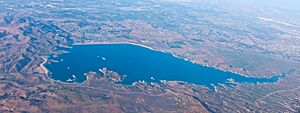Lake Mathews facts for kids
Quick facts for kids Lake Mathews |
|
|---|---|

A view of Lake Mathews from a distance.
|
|
| Location | Riverside County, California |
| Coordinates | 33°50′25″N 117°26′07″W / 33.8403°N 117.4352°W |
| Type | reservoir |
| Primary inflows | Colorado River Aqueduct |
| Primary outflows | Pipelines to member water agencies in the greater Los Angeles area |
| Basin countries | United States |
| Max. length | 4 mi (6.4 km) |
| Max. width | 2 mi (3.2 km) |
| Average depth | Approx. 150 ft (46 m) |
| Water volume | 182,000 acre-feet (224 hm3) |
| Shore length1 | Approx. 14 mi (23 km) |
| Surface elevation | 1,391 ft (424 m) |
| Islands | several small islands; number present depends on reservoir level |
| 1 Shore length is not a well-defined measure. | |
Lake Mathews is a very large reservoir (a human-made lake for storing water) in Riverside County, California. It sits in the Cajalco Canyon, which is in the hills of the Temescal Mountains. This lake is the end point for the Colorado River Aqueduct. This huge aqueduct brings much of the water used by cities and towns in Southern California.
The reservoir is fenced off, and people are not allowed to visit it. The lake is close to the community of Lake Hills. Roads like Cajalco Road, El Sobrante Road, and La Sierra Avenue go around it. Engineers built a large dam made of earth on one side of the lake. Two smaller dams, called dikes, were added in 1961 to make the lake even bigger.
Building Lake Mathews: A Look Back
The reservoir was first called the Cajalco Reservoir. It is now named after W.B. Mathews, a lawyer who helped create the Metropolitan Water District (MWD). This district manages water for many areas.
Building the reservoir started in 1933. This was at the same time the big aqueduct was being built across the desert. The land where the lake now sits used to have carob orchards and tin mines. The main dam and its water intake system were finished in 1939. The first water from the Colorado River arrived in February 1940. Water deliveries to cities began in 1941. In 1961, the lake's size was almost doubled. It can now hold 182,000 acre-feet of water.
In the mid-2000s, a big project took place. Workers fixed the old water outlet tower and built a new one. The MWD was worried about the old tower being damaged by earthquakes. Also, many of its large valves were not working because they were so old. To do this work without stopping the water supply, a temporary dam was built. Large concrete tunnels were also built to connect the new tower to the existing water system.
Lake Mathews Ecological Reserve: A Home for Wildlife
Lake Mathews is surrounded by about 4,000 acres of protected land. In 1982, this land became a state ecological reserve. This means it is a special place to protect nature. In the early 1990s, another 9,000 acres were added. This happened after an endangered animal, the Stephen's kangaroo rat (Dipodomys stephensi), was found there. The whole area is now called the Lake Mathews Estelle Mountain Reserve.
The Lake Mathews area is a very important spot for birds. Many birds rest and find food here, especially in the winter. You can see different kinds of ducks. Also, double-crested cormorants (Phalacrocorax auritus), western grebes (Aechmophorus occidentalis), eared grebes (Podiceps caspicus), golden eagles (Aquila chrysaetos), and bald eagles (Haliaeatus leucocephalus) visit during the colder months.
Lake Mathews and the Santa Ana River
Lake Mathews was built in a natural dip in the land. This area used to have a stream called Cajalco Creek. Any water flowing down this creek now goes into the reservoir. Cajalco Creek usually flows into the Santa Ana River.
In 2003, a state water board found that the MWD was stopping water from Cajalco Creek. This was against state water rules. The MWD and the state reached an agreement. The MWD agreed to keep track of how much water enters Lake Mathews from the creek. Then, they would release 1.3 times that amount of water into the Santa Ana River. They also agreed to give $50,000 to help remove a non-native plant called arundo grass (Arundo donax) from the Santa Ana River.




